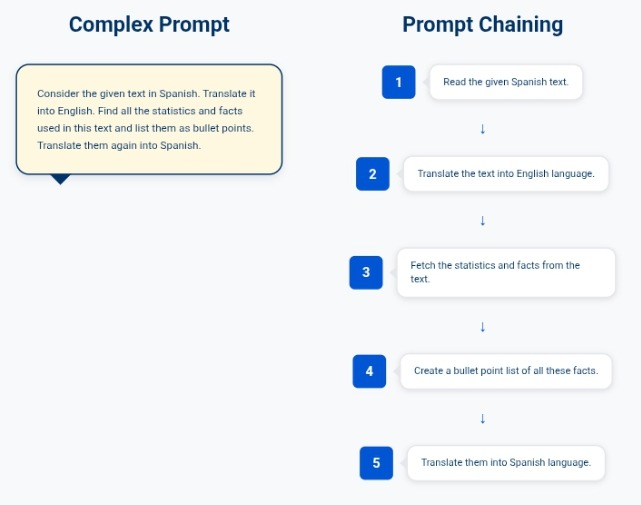You ask AI for help with a work project, and it gives you a generic response that could apply to anyone. You try again with a different question, and the answer still misses what you actually need. After a few attempts, you’re frustrated and wondering if AI is really that helpful after all.
This happens to most people when they start using AI tools. They treat AI like Google—ask a quick question and hope for a good answer. But AI works differently.
According to Anthropic’s research, poor prompting is the biggest challenge AI users face. It’s not that AI isn’t capable—it’s that we haven’t learned how to communicate clearly with it yet.
But here’s the good news: small changes in how you ask questions can dramatically improve the results you get. You don’t need technical skills or complex strategies. You just need to understand how to give AI the right information to help you.
In this guide, you’ll learn five techniques that will immediately improve your AI results. These work with any AI tool and take just a few extra seconds to apply.
Technique 1: Give AI Context About Your Situation

Most people ask vague questions like “How do I get more clients?” and wonder why the advice doesn’t fit their situation.
Instead, tell AI about your specific circumstances:
Vague question: “How do I improve my marketing?”
Better approach: “I’m a freelance graphic designer who works with small healthcare businesses. My current clients find me through referrals, but I want to try social media marketing. I have about 10 hours per week for marketing and a $500 monthly budget. What specific strategies should I focus on first?”
Why this works: AI now knows your industry, how you currently get clients, your time limits, and your budget. It can give you targeted advice instead of general marketing tips.
More examples:
For career advice: “I’m a financial analyst at a 500-person tech company. I’ve been in my role for two years and consistently meet my targets, but I want to get promoted to senior analyst within the next year. What specific actions should I take?”
For business decisions: “I run a 15-person marketing agency. We’ve grown steadily for three years but we’re hitting capacity limits. I want to increase revenue per client rather than taking on more clients. What are some ways to expand services with existing clients?”
The key: Give AI enough background to understand your specific situation, but focus on details that directly affect the advice you need.
Technique 2: Ask AI to Take on a Specific Role
AI gives much better advice when you tell it what kind of expert you need.
Instead of general questions, assign AI a specific role:
Basic question: “Should I raise my prices?”
Better approach: “Act as an experienced business consultant who helps small businesses with pricing decisions. You understand the challenges of raising prices without losing clients. Should I raise my prices, and if so, how should I approach it with my existing clients?”
Why this works: AI now approaches your question from the viewpoint of a specific type of expert, giving you more focused and relevant advice.
Role examples that work well:
- “Act as a career coach who helps people advance in tech companies”
- “Take the role of a marketing strategist who specializes in small business growth”
- “Function as a project manager who helps teams stay organized and meet deadlines”
For complex decisions, try multiple viewpoints: “First, analyze this decision from the viewpoint of a financial advisor focusing on costs. Then, give me the perspective of a marketing expert thinking about customer impact.”
The key: The more specific the role, the more targeted the advice becomes.
Technique 3: Show AI Examples of What You Want
AI understands examples better than descriptions. If you want something specific, show AI what good looks like.
Instead of describing what you want, provide examples:
Vague request: “Write a professional follow-up email.”
Better approach: “Write a follow-up email to a potential client. Here’s an example of the tone I want:
[Insert your example email]
Now create a similar email for this situation: [describe your specific context].”
For business analysis: “Analyze this situation and give me recommendations. Format your response like this:
Summary: (2-3 sentences about the situation) Main Issues: (3 bullet points) Recommended Actions: (numbered list with timeline) Expected Results: (what should happen)
Now apply this format to: [your situation]”
Why this works: AI matches the style, tone, and level of detail in your examples rather than guessing what you consider “professional.”
The key: Choose examples that represent the quality and style you want, not just any example in the same category.
Technique 4: Set Clear Limits
AI often gives advice that sounds good but ignores your real-world limitations. Setting clear boundaries ensures you get practical suggestions.
Always include your actual constraints:
Generic request: “How should I market my business?”
Better approach: “Suggest marketing strategies I can implement within 2 weeks, working 5 hours per week, with a maximum budget of $1,000 monthly. I have basic design skills and use Canva and social media platforms. Don’t suggest solutions that require advanced software or video editing.”
Types of limits to include:
Time constraints: “I can spend 2 hours per week on this”
Budget limits: “Maximum budget of $500 monthly”
Skill constraints: “I have basic computer skills but no coding experience”
Audience limits: “This needs to work for conservative financial services clients”
Format limits: “Give me exactly 5 recommendations, each taking 30 minutes or less to implement”
Why this works: You get realistic advice you can actually use instead of theoretical suggestions that don’t fit your situation.
Technique 5: Break Complex Questions into Steps
When you have a complex decision or problem, break it into smaller pieces so AI can think through each part thoroughly.
Instead of asking everything at once, create a step-by-step approach:
Complex question: “Should I expand my business?”
Better approach: “Help me evaluate whether to expand my consulting practice. Let’s work through this step by step:
Step 1: Analyze my current financial position and capacity Step 2: Look at market demand for my services
Step 3: Check out the competition and where I fit Step 4: Calculate what expansion would require Step 5: Give me decision criteria and next actions
Let’s start with Step 1.”
For project planning: “Help me plan a website project for a client.
Step 1: Define the project scope and requirements Step 2: Identify potential problems and risks Step 3: Create a realistic timeline with milestones Step 4: Figure out resource needs and budget Step 5: Plan communication with the client”
Why this works: Each step builds on the previous analysis, creating a more complete understanding instead of rushing to conclusions.
Why this works: Each step builds on the previous analysis, creating a more complete understanding instead of rushing to conclusions.
Using These Techniques Together
The most effective approach combines multiple techniques:
- Start with role assignment and context
- Provide examples of what you want
- Set clear limits
- Break complex problems into steps
Example combining all techniques: “Act as an experienced freelance business consultant. I’m a graphic designer with 5 years of experience, currently earning $75K annually working with small businesses. I want to increase my income to $100K within 12 months without working more than 40 hours per week. My current hourly rate is $65. Here’s an example of the kind of analysis I want: [provide example]. Keep your response to 300 words maximum and give me exactly 3 strategies to consider. Let’s start by analyzing my current situation, then look at rate increase options, then explore value-add services.”

Common Mistakes to Avoid
Asking multiple unrelated questions at once → Stick to one clear objective per conversation
Using vague language → Be specific about what you need
Not specifying format → Tell AI if you want bullet points, paragraphs, or lists
Accepting poor first results → If the response isn’t quite right, adjust your prompt rather than editing the output
Trying to solve complex problems in one prompt → Break complicated issues into logical steps
What to Expect
These techniques won’t make AI perfect, but they will make it much more useful. You’ll get responses that fit your specific situation, match your professional needs, and give you actionable advice you can use right away.
The key is practice. Start with simple prompts and gradually add more detail as you see what works best for your needs.
Remember: AI is a tool that gets better when you learn to communicate with it clearly. These techniques are your foundation for getting consistent, useful results.
Your Next Step: Building Complete AI Skills
The prompting techniques you’ve learned here will immediately improve your AI results. But we’ve noticed something interesting: professionals who get the most value from AI don’t stop at better prompting.
They develop complete AI skills that help them across all areas of their work. They learn to use AI for research, analysis, content creation, project planning, and strategic thinking in ways that create real advantages in their careers and businesses.
At AI Literacy Academy, we teach the full range of AI skills that go beyond prompting. Our members learn systematic approaches to AI that help them work more effectively, make better decisions, and stay ahead of changes in their industries.
The difference between knowing prompting techniques and having complete AI skills is the difference between getting better answers and transforming how you approach your work.
These prompting techniques show you’re ready to explore what else becomes possible when you develop comprehensive AI capabilities.
Ready to build AI skills that help you across every area of your professional work?
Visit AI Literacy Academy to learn how we help professionals develop complete AI capabilities that create lasting advantages in their careers and businesses.
